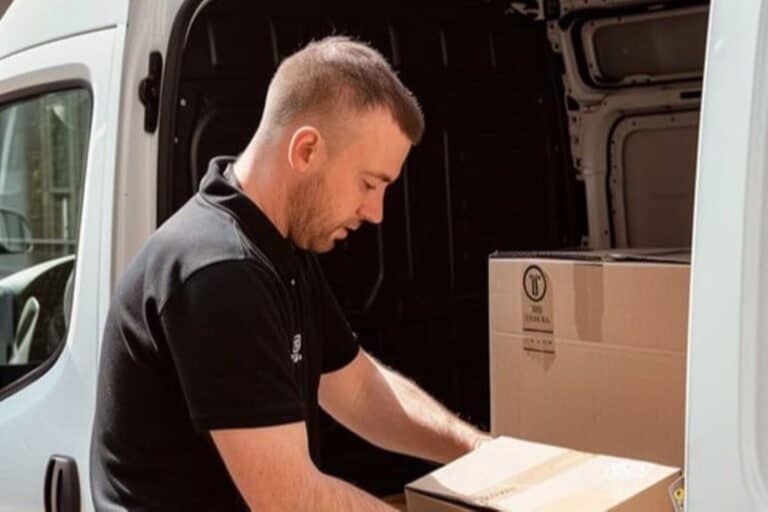The cost of a man and van service is influenced by several factors, including the distance of the move, the volume and weight of items being transported, the duration of the job, the type of van required, and any additional services requested. Understanding these factors is essential for effective budgeting, as they help prevent unexpected costs. By being aware of these elements, you can make informed decisions to optimise your moving expenses and ensure a smooth transition.
Key Takeaways
- Key factors influencing man and van service costs include distance, volume and weight of items, job duration, type of van, and additional services.
- Choosing the appropriate size van (small, medium, large) can optimise costs, with larger vans potentially reducing the need for multiple trips, despite higher rental rates.
- Scheduling moves during off-peak times, and avoiding peak seasons can lead to significant savings in moving expenses.
Key Elements Affecting Man and Van Service Costs
Several factors influence the overall moving cost when hiring a man and van service. These include the distance and travel time, the volume and weight of items, the duration of the job, the type of van used, and any additional services required. Knowing these factors enables more accurate budgeting and helps avoid unexpected expenses. Each of these factors contributes to the overall costs in different ways.
For example, long-distance moves typically incur higher fuel costs and travel time, while the volume and weight of your belongings can determine the size of the van needed and the number of trips required. The job’s duration can impact hourly rates, and extra services such as packing and storage can also significantly influence the final cost. Let’s delve deeper into these aspects.
Distance and Travel Time
Distance and travel time play vital roles in determining the total cost of a man and van service. Local moves within the same city are generally cheaper because they involve shorter distances and lower fuel consumption. However, long-distance moves can dramatically increase the overall cost due to higher fuel consumption, travel time, and potential tolls.
Moving across the country takes more time and incurs higher expenses due to per-mile rates and fuel costs. Longer travel times can impact scheduling and service availability, potentially leading to additional costs. Removal companies might also add a per-mile charge to the hourly rate for these long-distance moves, further increasing the moving expenses.

Volume and Weight of Items
The volume and weight of items significantly contribute to the overall moving cost. Larger and heavier items generally require bigger vans and more fuel, directly increasing the costs involved. For example, if you have a lot of heavy or bulky items, you may need a larger van or even multiple trips, which can significantly impact the overall costs.
To make the move more efficient and cost-effective, it’s advisable to declutter and reduce the volume of items before the move. Moving heavy items often requires more movers, typically 2 to 4, to ensure safe lifting and transport. This additional labour also contributes to the overall moving cost.
Duration of the Job
The duration of the job is another key factor that influences the cost of a man and van service. Most van services charge by the hour, with rates starting at around £17 per hour in Ilford. Therefore, the longer the job takes, the higher the overall cost will be.
Unexpected obstacles and difficult property layouts can significantly prolong the moving process, leading to increased costs. To avoid unexpected moving costs, it’s essential to plan accurately and estimate the time required for the move. This helps in ensuring that the billing remains within your budget and avoids any extra labour charges or overtime expenses.
Types of Vans and Their Costs
Choosing the right type of van is crucial for an efficient and cost-effective move. Different van sizes, including small, medium, and large, have varying costs that significantly influence the total expenses. Selecting a van that fits all your items properly can avoid damage during transit and eliminate the need for multiple trips.
The cost of hiring a standard moving van for a day in the UK typically ranges between £279 to £469. However, the actual cost can vary depending on the van size, duration of hire, and specific services required.
Let’s explore the van cost implications of small, medium, and large vans.
Small Transit Vans
Small transit vans are a popular choice for local moves or transporting smaller loads. Hiring a small transit van typically ranges from £300 to £350 for a full day. These vans are ideal for short distances and can be more cost-effective for smaller moves.
However, it’s essential to ensure that the van size is appropriate for your load. A van that’s too small may necessitate multiple trips, increasing overall fuel and labour costs. Therefore, careful planning and accurate assessment of your moving needs are crucial.
Medium-Sized Vans
Medium-sized vans offer a balance between cost and capacity. The rental cost of these vans typically falls between that of small transit vans and large vans, providing a better price per cubic capacity. They are suitable for moves that require a balance of space and budget efficiency.
Medium-sized vans offer more capacity than small vans, reducing the need for multiple trips. This makes them a cost-effective solution for mid-sized moves, offering adequate space without the higher costs associated with larger vans.
Large Vans
Large vans are ideal for extensive moves that involve heavy or bulky items. While renting a larger van generally incurs higher expenses compared to smaller options, it can be cost-effective as it allows for fewer trips, potentially balancing out the higher rental cost.
Designed to accommodate bulky and large loads, these vans suit long-distance moves or house relocations. Despite the initial higher cost, using a large van can prove economically advantageous, especially if it eliminates the need for multiple trips.
NOTE
When moving to Ilford, selecting the right van size is key to managing costs effectively. Understanding how small, medium, and large vans impact overall expenses can help you make an informed decision that balances affordability and convenience.
Additional Services and Their Impact on Costs
Additional services like packing, storage, and insurance can significantly alter the total moving expenses. These extra services, while convenient, add to the final cost of a man and van service. Understanding the impact of these additional costs is essential for effective budgeting during a move.
Some common additional services include professional packing, storage solutions, and various insurance coverages. These services provide added convenience and protection but come at an extra cost. Let’s explore these services in more detail.
Professional Packing Services
Hiring professional packing services can increase the overall costs of a move. Though these services add to the budget, they offer invaluable efficiency and protection for your items. Packing services typically include the supply of packing materials, professional packing of items, and sometimes even unpacking at the destination. This added convenience can save you time and ensure that your belongings are well-protected during transit, especially when you choose a reliable service provider.
Storage Solutions
Using a storage facility during a move incurs rental fees along with transportation costs to and from the storage unit. Storage rental fees vary depending on the unit’s size and location. Transportation costs depend on the distance to the storage facility and the number of trips required. These costs together can significantly impact the overall moving budget. These factors should be taken into account when planning your move. Careful consideration of these factors is essential.
Insurance Coverage
Many man and van services typically offer insurance policies to protect your belongings during the move. In the UK, hire and reward insurance is legally required for a man with a van service. Public liability insurance covers liabilities arising from accidents or injuries during the moving service. Additionally, goods-in-transit insurance covers damages to items being transported. Additional coverage might increase costs but offers crucial protection for your belongings.
Seasonal Demand and Pricing Variations
Seasonal fluctuations significantly impact demand and price changes for moving services. The demand for these services typically increases during the peak seasons, leading to higher prices. To reduce costs, it’s advisable to avoid scheduling moves during peak seasons, particularly from May to September and on weekends. Knowing these seasonal variations aids in planning your move more cost-effectively. Let’s delve into the specifics of peak season costs and off-peak season savings.
Peak Season Costs
Prices for moving services typically rise during the summer months due to increased demand. Peak moving seasons occur in spring and summer when the demand for moving services is highest. During peak seasons, the final moving cost can be significantly higher due to increased fuel costs, additional fees, and higher expenses. Therefore, planning your move during these peak seasons can lead to higher overall costs.
Off-Peak Savings
Moving during off-peak times, such as winter or weekdays, can be beneficial. It can result in substantial savings. Winter moves can result in considerable cost savings compared to peak seasons. Weekday moves are generally more cost-effective compared to weekends. These cost reductions can help you budget effectively and save money while providing significant savings on your move.
Complexity of the Move

The complexity of the moving process can significantly impact the overall moving cost. Factors such as narrow staircases, lack of elevators, and unique property layouts can complicate a move. Limited access to a building increases loading and unloading time, impacting overall costs. Additional complexities requiring extra effort and resources increase the overall moving cost. Let’s explore how navigating obstacles and handling fragile items contribute to these costs.
Navigating Obstacles
Complex property layouts can slow the moving process and increase costs. Navigating obstacles can significantly impact moving costs due to additional labour and time requirements. Careful planning and assessment of potential obstacles are crucial to avoiding unexpected costs and ensuring a smooth move.
Special Handling for Fragile Items
Handling delicate items necessitates extra care and specialised packing, contributing to higher costs. These items require additional services such as professional packing and careful handling during the move. Extra precautions for fragile or high-value items can add to moving expenses, necessitating budget adjustments for these services.
Ensuring Accurate Quotes and Avoiding Hidden Fees
Requesting a detailed quote uncovers additional fees and ensures pricing transparency. Providing a detailed inventory of items, including their size, weight, and any complexities, helps secure an accurate quote for moving services.
Clarifying potential hidden fees during the quoting process helps avoid unexpected costs and determine the final price. Online platforms simplify the process of finding the best rates by allowing easy comparison of quotes from different service providers.
Summary
We can see that various factors influence the cost of man and van services. From distance and travel time, volume and weight of items, duration of the job, and the type of van used, to additional services and seasonal demand, all these factors contribute to the overall moving cost. Understanding these factors and planning accordingly can help you budget effectively and avoid unexpected expenses. By making informed decisions and comparing quotes, you can ensure a smooth and cost-effective move.
Frequently Asked Questions
What is a man with a van service?
A man with a van service is a moving solution where one to three people assist with transporting items using a single van, making it ideal for various moving needs, from household goods to larger items. This service offers a convenient and flexible option for those requiring assistance with their move.
Is it cheaper to hire a van or a man with a van?
It is often more cost-effective to hire a man with a van, as this service can help you avoid hidden costs and risks associated with a DIY move. Ultimately, considering the overall value and convenience may lead you to this option.
What two factors most influence transportation costs?
Transportation costs are most influenced by market conditions, particularly fuel prices, and geographical factors like distance and terrain. Understanding these factors can help in effectively managing and optimising transportation expenses.
What factors influence the cost of a man and van service?
The cost of a man and van service is primarily influenced by distance, travel time, the volume and weight of items, duration of the job, and any additional services needed. Other factors like the type of van and seasonal demand also play a significant role.
How can I reduce the cost of my move?
Decluttering your belongings before the move can significantly lower costs, along with selecting the right van size and planning your move during off-peak times. In addition, try to minimise the use of extra services to further save on expenses.






